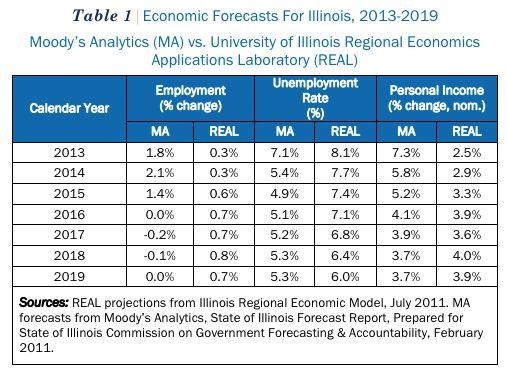
I'll probably be spending more time with this in the coming days, but it's worth calling attention to this: the State Budget Crisis Task Force, and its new report on Illinois. The Task Force represents something of a bureaucratic dream team: an alliance between Richard Ravitch (whose CV is way too long to list here) and Paul Volcker (former Fed secretary, chair of Obama's economic recovery team). They set out to diagnose the fiscal problems of a handful of states, and Illinois, for obvious reasons, is one of them.
The result… well, it's apparent, and it's all been said before in one way or another. But it's clear and concise, and it's a good one-stop shop for most of the state's many problems. (At 53 pages, not including footnotes, it's extremely concise, all things considered.
It's got history:
In 2000 the pension systems were relatively sound, but the economic recession of 2000-2003 was disastrous for the systems’ asset values. The funded ratio for the five systems combined plummeted to 49 percent in 2003. In response, pension benefits were reduced, the state issued $10 billion in bonds (of which $7.3 billion went to the pension systems), and legislation was enacted allowing a “partial pension holiday” for FYs 2006 and 2007. Although the intent of borrowing was to reduce unfunded liabilities, the statute was written such that the required contributions going forward included the amount of debt service on these bonds, which reduced the amount actually contributed to the pensions and worsened the chronic underfunding. The 2006 and 2007 contributions made during the pension holidays were only about half the amount required based on actuarial calculations. So the financial condition of the pensions continued to deteriorate.
It's got outliers that I only dimly understand:
Further complicating the issue, the bulk of Illinois’ Medicaid spending is for acute care. In 2010, 73 percent of Illinois’ Medicaid dollars went to acute care, compared to the national average of 64 percent. Nearly half of Illinois’ spending on acute care (48 percent) went to inpatient hospital expenses, while the U.S. average was 21 percent.
(I have touched on the inpatient expenses aspect a bit. Some of it is structural: "'Optional' treatments such as medications and preventive care can be cost-effective alternatives to hospitalization, but under the current federal rules these are the first services to be cut.")
It's got a bleak portrait of the state's near future:

But it's not all reasons Illinois needs to spend less money. Some of it's a warning about things we need to spend more money on, even though we can't:
As critical as the condition of Illinois’ infrastructure is, it is unlikely that the state will be able to allocate additional resources to fix the problems in the foreseeable future. This is because the growth in spending for pensions, Medicaid, and debt service will out-pace the anticipated growth in Illinois’ resources. Except for the 2011 increases in the personal and corporate income tax rates, Illinois’ tax revenues have been stagnant for over a decade. The revenues from the tax increase have been offset by the decline in federal receipts as the stimulus program ended. And deeper cuts in federal funding are on the horizon, as the federal government works to reduce its own deficit.
Likely you're aware of some of these things, but it is a good rundown; the state's many fiscal problems are tough to keep in one's head, so it's good to have most of the major ones in one place. What it doesn't have much of is solutions: "the state needs to recognize that large cuts in many areas of the budget as well as increases in revenues will be necessary"; "Illinois could learn from hybrid systems adopted in a number of other states"; "Illinois should work with the federal government to control Medicaid costs and implement reforms"; "Illinois should reform its income and sales tax structures to make them broader-based, stable, and productive"; etc.
There are some hints among the lengthy accounting of our sins, but otherwise its recommendations are the white-paper equivalent of "study needed inventions."
Photograph: mrsdkrebs (CC by 2.0)


